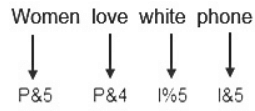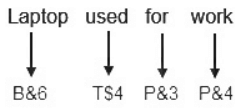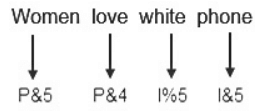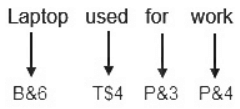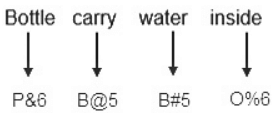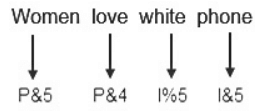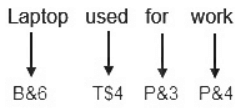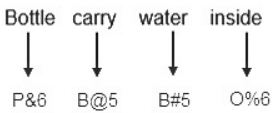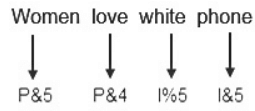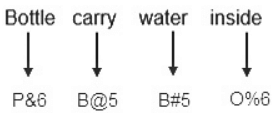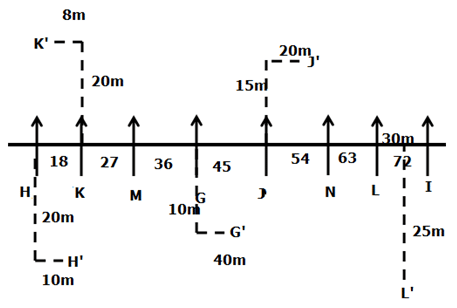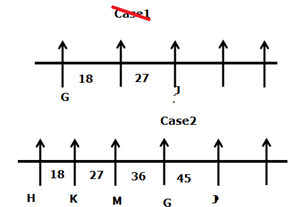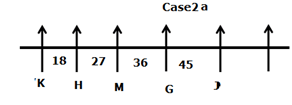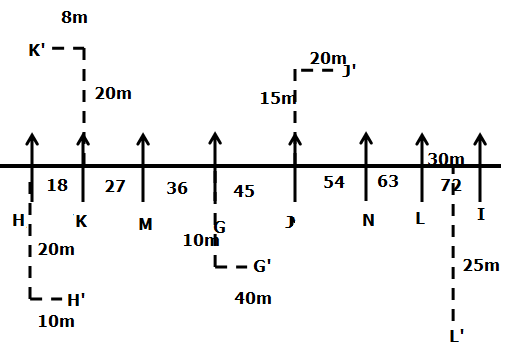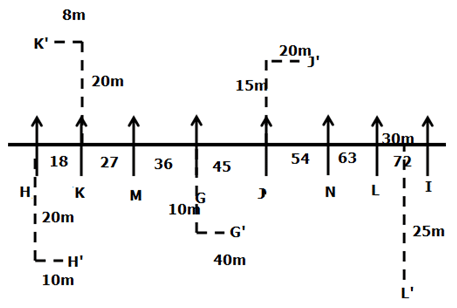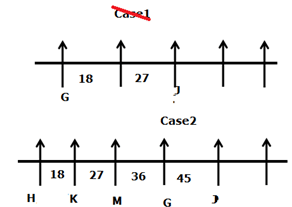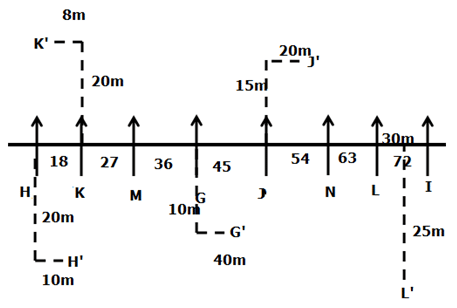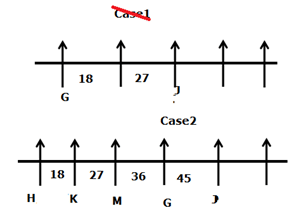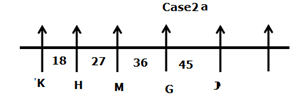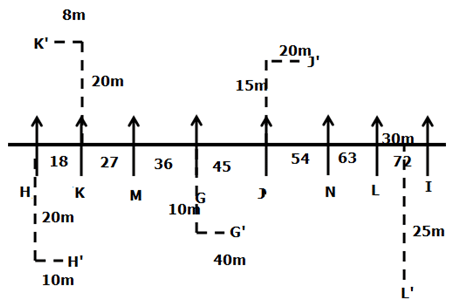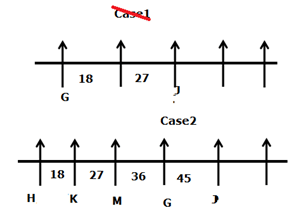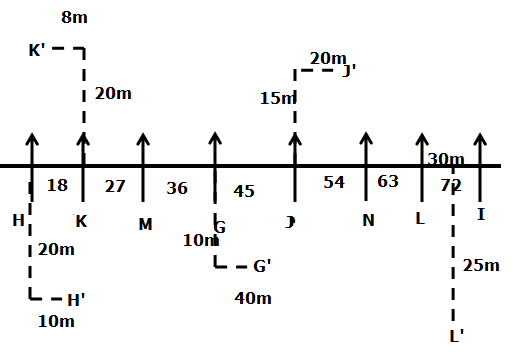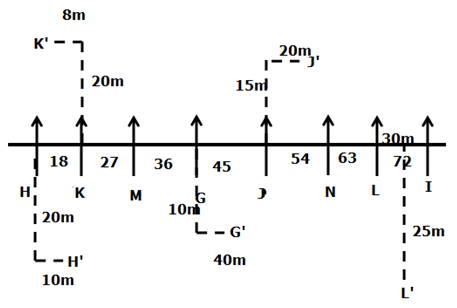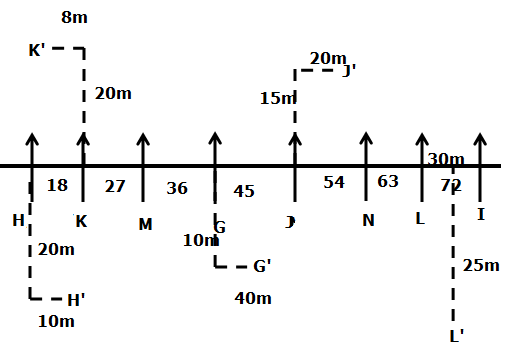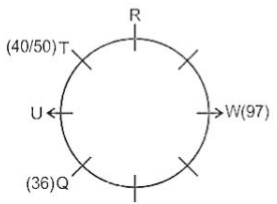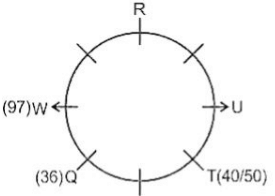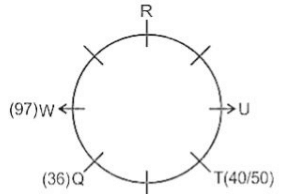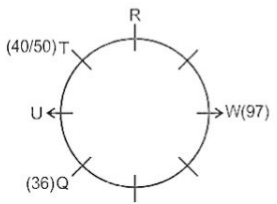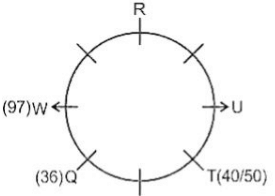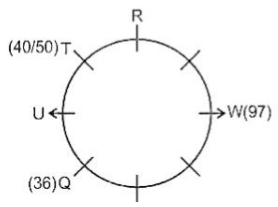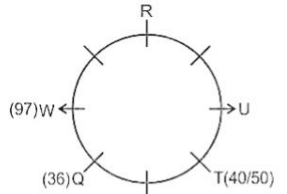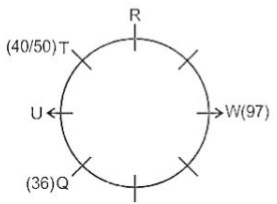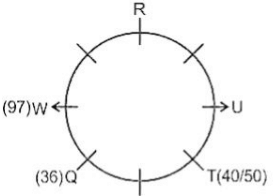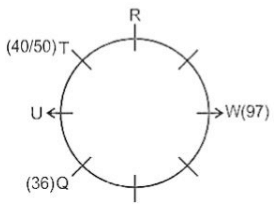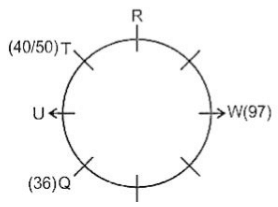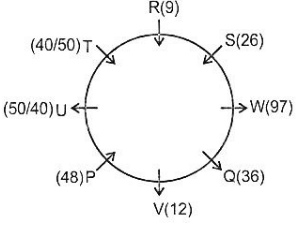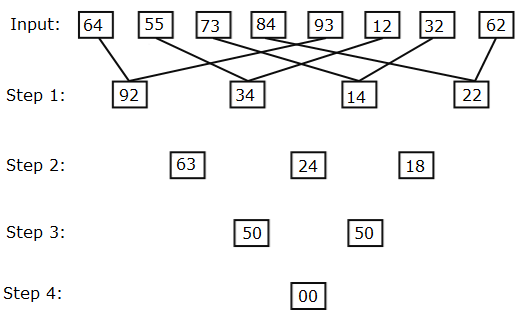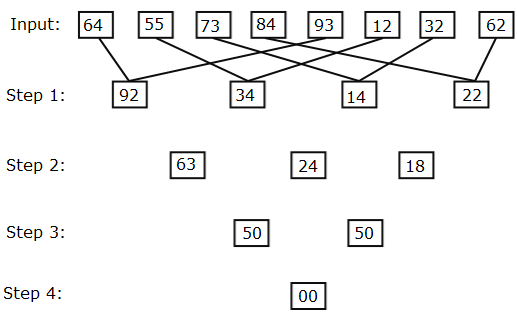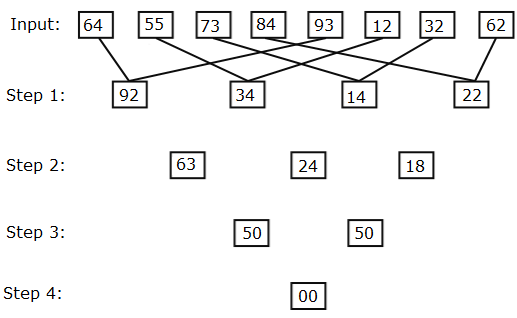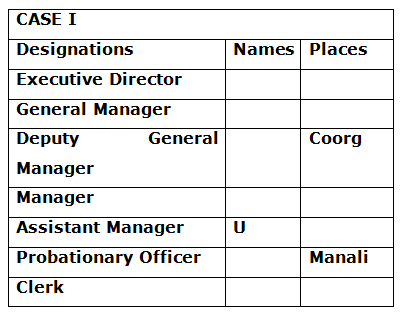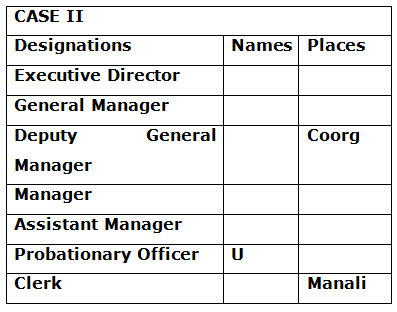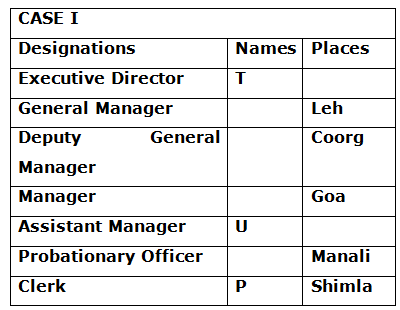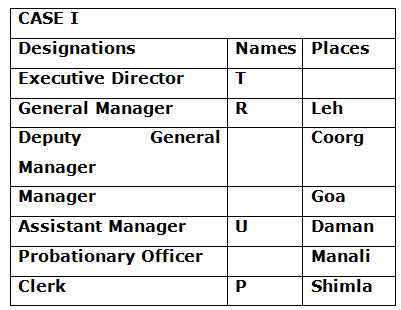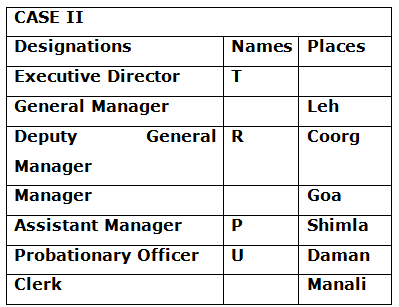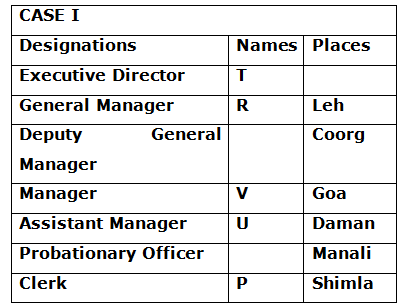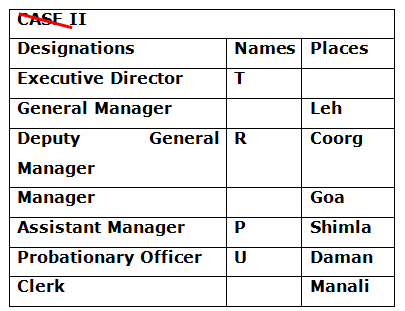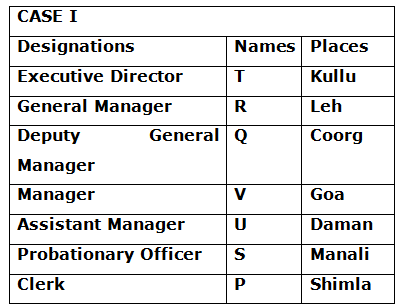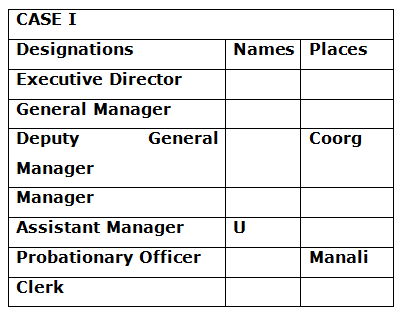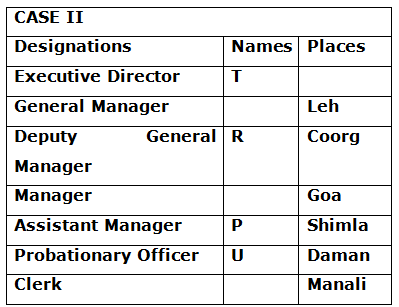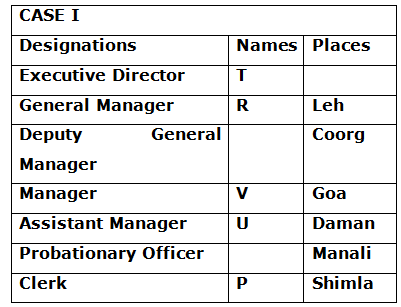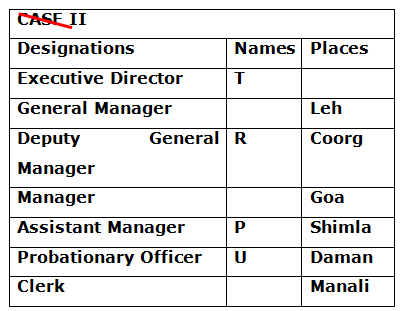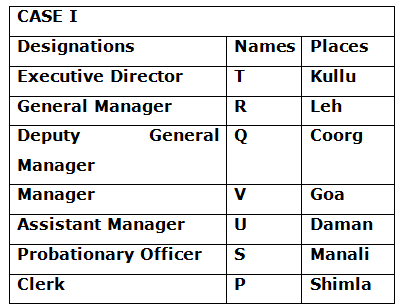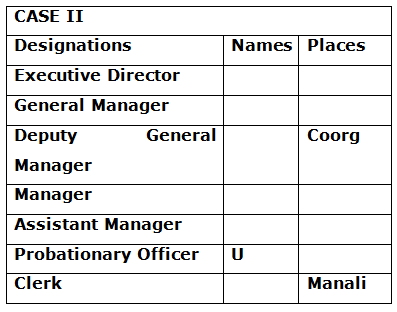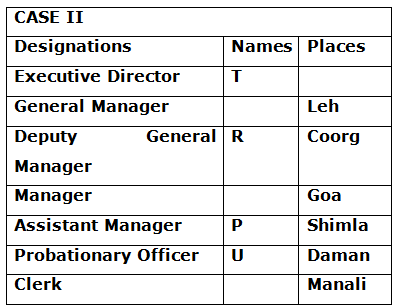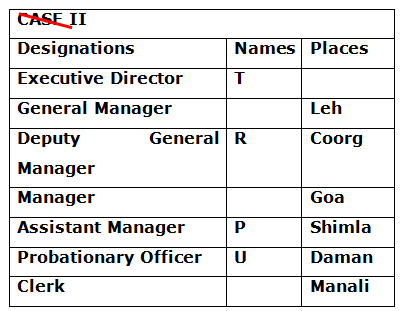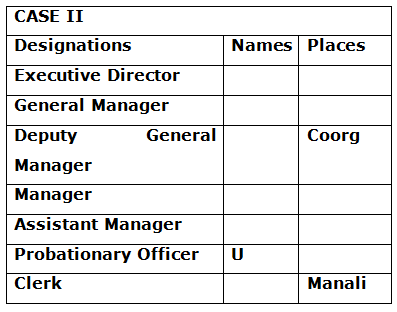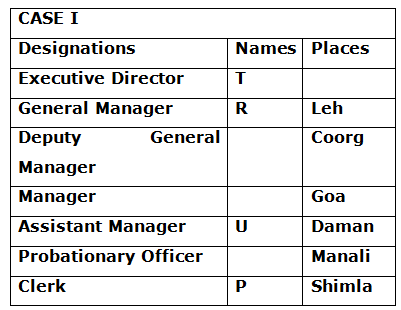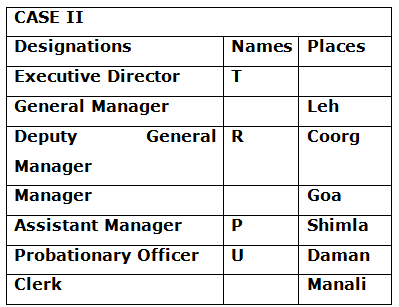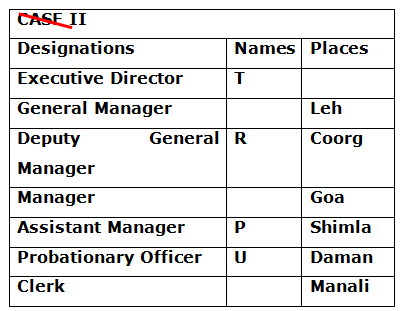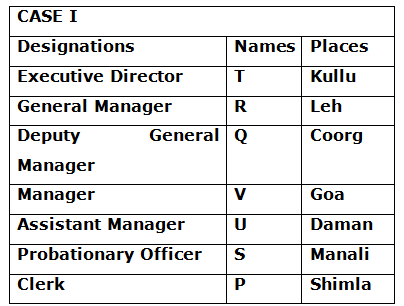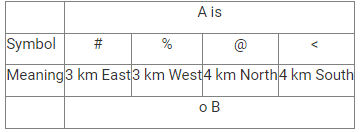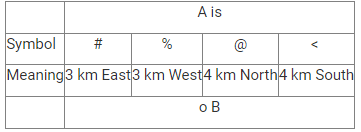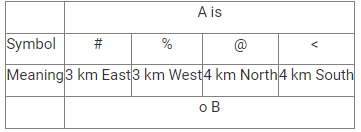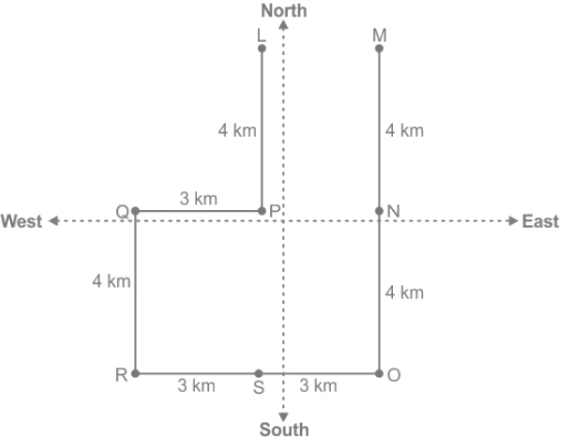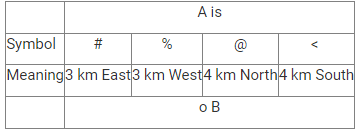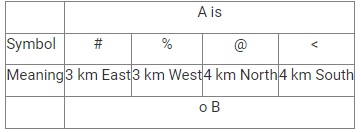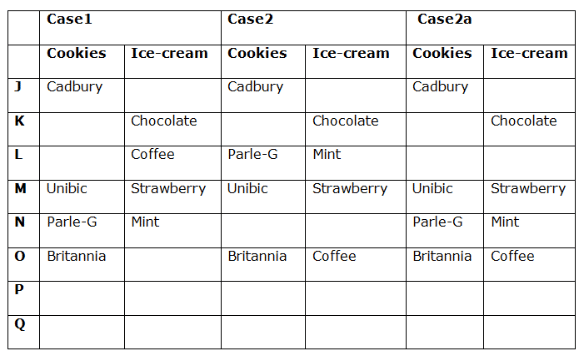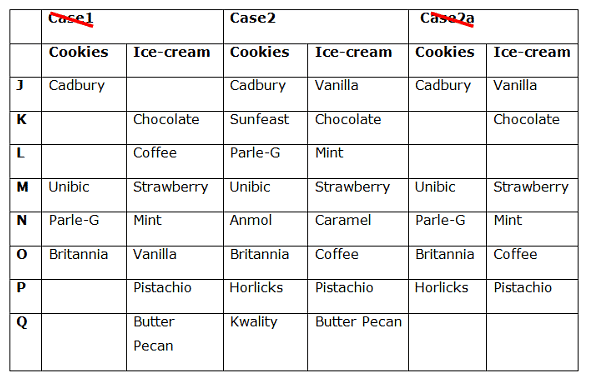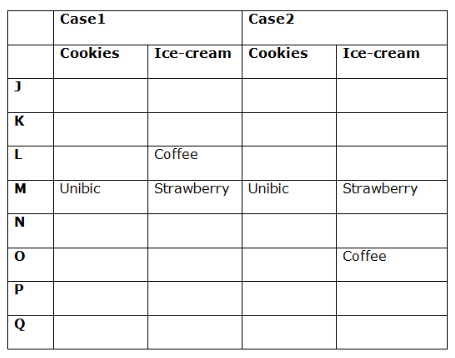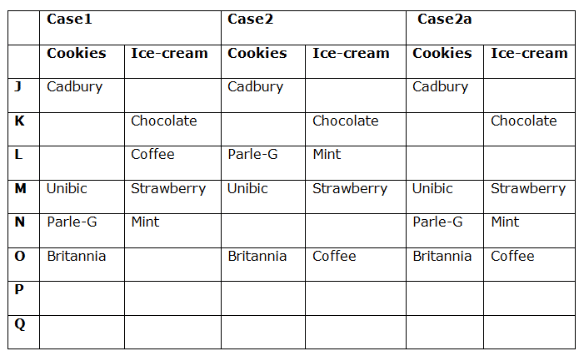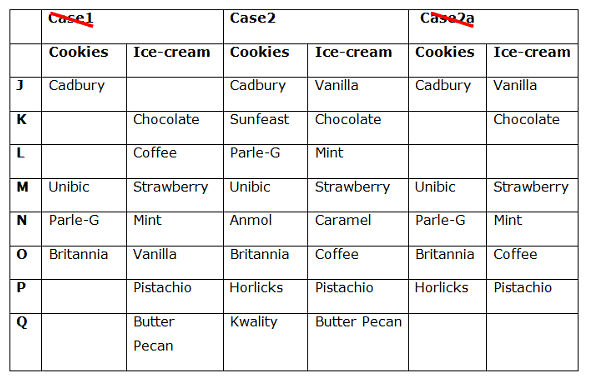RBI Assistant Mains Mock Test - 1 - Bank Exams MCQ
30 Questions MCQ Test - RBI Assistant Mains Mock Test - 1
Direction: Study the information given carefully and answer the question given below.
In a certain code language,
“Women love white phone” is coded as “P&4, I&5, P&5, I%5”.
“Laptop used for work” is coded as “T$4, P&3, B&6, P&4”.
“Bottle carry water inside” is coded as “B@5, B#5, O%6, P&6”.
What is the code for the word ‘water’?
Direction: Study the information given carefully and answer the question given below.
In a certain code language,
“Women love white phone” is coded as “P&4, I&5, P&5, I%5”.
“Laptop used for work” is coded as “T$4, P&3, B&6, P&4”.
“Bottle carry water inside” is coded as “B@5, B#5, O%6, P&6”.
In the given code language, what does the code P&4 means?
Direction: Study the information given carefully and answer the question given below.
In a certain code language,
“Women love white phone” is coded as “P&4, I&5, P&5, I%5”.
“Laptop used for work” is coded as “T$4, P&3, B&6, P&4”.
“Bottle carry water inside” is coded as “B@5, B#5, O%6, P&6”.
What is the code for the word ‘used’ in the given code language?
Direction: Study the information given carefully and answer the question given below.
In a certain code language,
“Women love white phone” is coded as “P&4, I&5, P&5, I%5”.
“Laptop used for work” is coded as “T$4, P&3, B&6, P&4”.
“Bottle carry water inside” is coded as “B@5, B#5, O%6, P&6”.
As per the given code language, what would be the code for ‘must watch’?
Read the following information carefully and answer the questions given below.
Eight person namely-G, H, I, J, K, L, M, and N are sitting in the linear facing north. Distance between adjacent persons is a consecutive integral multiple of ‘9m’ from the left end. The distance between adjacent persons is neither less than 10m nor more than ‘80m’
G sits 45m left of J. The distance between M and G is twice the distance between H and K. G does not sit to the left of M. The distance between J and N is thrice of the distance between H and K. The number of persons sits to the left of H is the same as to the right of I. The one who sits second to the right of N is sitting immediate right of L.
After the above arrangement, K walks 20m towards the north then took a left turn and walks 8m to reach K’. H walks 20m towards the south then took the left turn and walks 10m to reach H’. G walks 10m towards south then took left turn and walks 40m to reach G’. J walks 15m towards the north then took the right and walks 20m to reach J’. L walks 30m towards the east then took the right turn and walks 25m to reach L’.
Who among the following person sits exactly between G and the one who sits immediate right of L before the movement?
Read the following information carefully and answer the questions given below.
Eight person namely-G, H, I, J, K, L, M, and N are sitting in the linear facing north. Distance between adjacent persons is a consecutive integral multiple of ‘9m’ from the left end. The distance between adjacent persons is neither less than 10m nor more than ‘80m’
G sits 45m left of J. The distance between M and G is twice the distance between H and K. G does not sit to the left of M. The distance between J and N is thrice of the distance between H and K. The number of persons sits to the left of H is the same as to the right of I. The one who sits second to the right of N is sitting immediate right of L.
After the above arrangement, K walks 20m towards the north then took a left turn and walks 8m to reach K’. H walks 20m towards the south then took the left turn and walks 10m to reach H’. G walks 10m towards south then took left turn and walks 40m to reach G’. J walks 15m towards the north then took the right and walks 20m to reach J’. L walks 30m towards the east then took the right turn and walks 25m to reach L’.
What is the distance between J and L before the movement?
Read the following information carefully and answer the questions given below.
Eight person namely-G, H, I, J, K, L, M, and N are sitting in the linear facing north. Distance between adjacent persons is a consecutive integral multiple of ‘9m’ from the left end. The distance between adjacent persons is neither less than 10m nor more than ‘80m’
G sits 45m left of J. The distance between M and G is twice the distance between H and K. G does not sit to the left of M. The distance between J and N is thrice of the distance between H and K. The number of persons sits to the left of H is the same as to the right of I. The one who sits second to the right of N is sitting immediate right of L.
After the above arrangement, K walks 20m towards the north then took a left turn and walks 8m to reach K’. H walks 20m towards the south then took the left turn and walks 10m to reach H’. G walks 10m towards south then took left turn and walks 40m to reach G’. J walks 15m towards the north then took the right and walks 20m to reach J’. L walks 30m towards the east then took the right turn and walks 25m to reach L’.
What is the direction of G’ with respect to L’ in the final arrangement?
Read the following information carefully and answer the questions given below.
Eight person namely-G, H, I, J, K, L, M, and N are sitting in the linear facing north. Distance between adjacent persons is a consecutive integral multiple of ‘9m’ from the left end. The distance between adjacent persons is neither less than 10m nor more than ‘80m’
G sits 45m left of J. The distance between M and G is twice the distance between H and K. G does not sit to the left of M. The distance between J and N is thrice of the distance between H and K. The number of persons sits to the left of H is the same as to the right of I. The one who sits second to the right of N is sitting immediate right of L.
After the above arrangement, K walks 20m towards the north then took a left turn and walks 8m to reach K’. H walks 20m towards the south then took the left turn and walks 10m to reach H’. G walks 10m towards south then took left turn and walks 40m to reach G’. J walks 15m towards the north then took the right and walks 20m to reach J’. L walks 30m towards the east then took the right turn and walks 25m to reach L’.
What is the direction and distance of K’ with respect to H’ in the final arrangement?
Read the following information carefully and answer the questions given below.
Eight person namely-G, H, I, J, K, L, M, and N are sitting in the linear facing north. Distance between adjacent persons is a consecutive integral multiple of ‘9m’ from the left end. The distance between adjacent persons is neither less than 10m nor more than ‘80m’
G sits 45m left of J. The distance between M and G is twice the distance between H and K. G does not sit to the left of M. The distance between J and N is thrice of the distance between H and K. The number of persons sits to the left of H is the same as to the right of I. The one who sits second to the right of N is sitting immediate right of L.
After the above arrangement, K walks 20m towards the north then took a left turn and walks 8m to reach K’. H walks 20m towards the south then took the left turn and walks 10m to reach H’. G walks 10m towards south then took left turn and walks 40m to reach G’. J walks 15m towards the north then took the right and walks 20m to reach J’. L walks 30m towards the east then took the right turn and walks 25m to reach L’.
What is the position of N from the extreme right end?
Direction: Study the following information carefully and answer the questions given below
Eight people P, Q, R, S, T, U, V, and W are sitting around a circular table. Four of them are facing the centre and four of them are facing opposite to the centre. Each of them is of different ages among 9, 12, 26, 36, 40, 48, 50, and 97. Each of them is of a different height.
T is not taller than the person who is sitting opposite to T. R, who is 9 years old, sits opposite to one, who sits adjacent to Q, whose age is 36 years. U sits opposite W, whose age is 97 years. T sits to the immediate right of U. U is taller than P, who is taller than R. R and W are not adjacent to each other. A person whose age is a prime number is facing opposite to centre of the circle. The one, whose age is 48 years, sits to the immediate right of one, whose age is 12 years. T age is in multiple of 10. S age is 26 years and is not adjacent to V. Both V and Q are adjacent to each other and facing the same direction. U age is in multiple of 5. The person sitting opposite S is elder to him. R is taller than W, who is taller than Q. V is taller than only the person, who is sitting opposite to P. S and P do not opposite to Q. U and W both face outside the centre.
Who among the following is 12 years old?
Direction: Study the following information carefully and answer the questions given below
Eight people P, Q, R, S, T, U, V, and W are sitting around a circular table. Four of them are facing the centre and four of them are facing opposite to the centre. Each of them is of different ages among 9, 12, 26, 36, 40, 48, 50, and 97. Each of them is of a different height.
T is not taller than the person who is sitting opposite to T. R, who is 9 years old, sits opposite to one, who sits adjacent to Q, whose age is 36 years. U sits opposite W, whose age is 97 years. T sits to the immediate right of U. U is taller than P, who is taller than R. R and W are not adjacent to each other. A person whose age is a prime number is facing opposite to centre of the circle. The one, whose age is 48 years, sits to the immediate right of one, whose age is 12 years. T age is in multiple of 10. S age is 26 years and is not adjacent to V. Both V and Q are adjacent to each other and facing the same direction. U age is in multiple of 5. The person sitting opposite S is elder to him. R is taller than W, who is taller than Q. V is taller than only the person, who is sitting opposite to P. S and P do not opposite to Q. U and W both face outside the centre.
Who sits third to the left of the 2nd tallest person?
Direction: Study the following information carefully and answer the questions given below
Eight people P, Q, R, S, T, U, V, and W are sitting around a circular table. Four of them are facing the centre and four of them are facing opposite to the centre. Each of them is of different ages among 9, 12, 26, 36, 40, 48, 50, and 97. Each of them is of a different height.
T is not taller than the person who is sitting opposite to T. R, who is 9 years old, sits opposite to one, who sits adjacent to Q, whose age is 36 years. U sits opposite W, whose age is 97 years. T sits to the immediate right of U. U is taller than P, who is taller than R. R and W are not adjacent to each other. A person whose age is a prime number is facing opposite to centre of the circle. The one, whose age is 48 years, sits to the immediate right of one, whose age is 12 years. T age is in multiple of 10. S age is 26 years and is not adjacent to V. Both V and Q are adjacent to each other and facing the same direction. U age is in multiple of 5. The person sitting opposite S is elder to him. R is taller than W, who is taller than Q. V is taller than only the person, who is sitting opposite to P. S and P do not opposite to Q. U and W both face outside the centre.
What is the difference in the age of T and U?
Direction: Study the following information carefully and answer the questions given below
Eight people P, Q, R, S, T, U, V, and W are sitting around a circular table. Four of them are facing the centre and four of them are facing opposite to the centre. Each of them is of different ages among 9, 12, 26, 36, 40, 48, 50, and 97. Each of them is of a different height.
T is not taller than the person who is sitting opposite to T. R, who is 9 years old, sits opposite to one, who sits adjacent to Q, whose age is 36 years. U sits opposite W, whose age is 97 years. T sits to the immediate right of U. U is taller than P, who is taller than R. R and W are not adjacent to each other. A person whose age is a prime number is facing opposite to centre of the circle. The one, whose age is 48 years, sits to the immediate right of one, whose age is 12 years. T age is in multiple of 10. S age is 26 years and is not adjacent to V. Both V and Q are adjacent to each other and facing the same direction. U age is in multiple of 5. The person sitting opposite S is elder to him. R is taller than W, who is taller than Q. V is taller than only the person, who is sitting opposite to P. S and P do not opposite to Q. U and W both face outside the centre.
Who sits opposite to V?
Direction: Study the following information carefully and answer the questions given below
Eight people P, Q, R, S, T, U, V, and W are sitting around a circular table. Four of them are facing the centre and four of them are facing opposite to the centre. Each of them is of different ages among 9, 12, 26, 36, 40, 48, 50, and 97. Each of them is of a different height.
T is not taller than the person who is sitting opposite to T. R, who is 9 years old, sits opposite to one, who sits adjacent to Q, whose age is 36 years. U sits opposite W, whose age is 97 years. T sits to the immediate right of U. U is taller than P, who is taller than R. R and W are not adjacent to each other. A person whose age is a prime number is facing opposite to centre of the circle. The one, whose age is 48 years, sits to the immediate right of one, whose age is 12 years. T age is in multiple of 10. S age is 26 years and is not adjacent to V. Both V and Q are adjacent to each other and facing the same direction. U age is in multiple of 5. The person sitting opposite S is elder to him. R is taller than W, who is taller than Q. V is taller than only the person, who is sitting opposite to P. S and P do not opposite to Q. U and W both face outside the centre.
Who among the following sits third to the left of the person, who is the 4th shortest person?
A string of numbers is given as input. The further steps given are obtained by applying certain logic. Each step is a resultant of previous step only. Study the following information carefully and answer the questions given below it.

Find the final step of the given input from the following?
A string of numbers is given as input. The further steps given are obtained by applying certain logic. Each step is a resultant of previous step only. Study the following information carefully and answer the questions given below it.
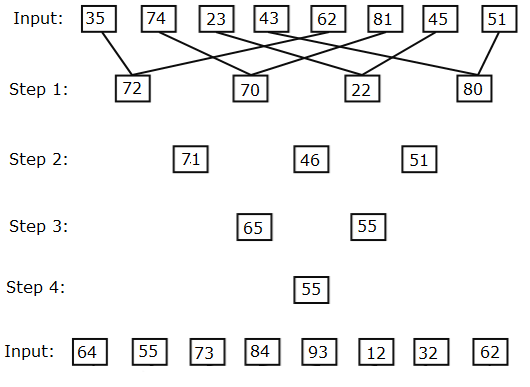
Find the sum of the first element from the left end in step 2 and in step 3 of the given input?
A string of numbers is given as input. The further steps given are obtained by applying certain logic. Each step is a resultant of previous step only. Study the following information carefully and answer the questions given below it.
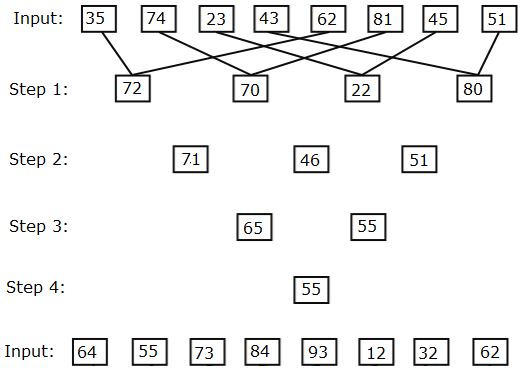
Calculate the square of the second element from the left end in step 3 of the given input?
A string of numbers is given as input. The further steps given are obtained by applying certain logic. Each step is a resultant of previous step only. Study the following information carefully and answer the questions given below it.
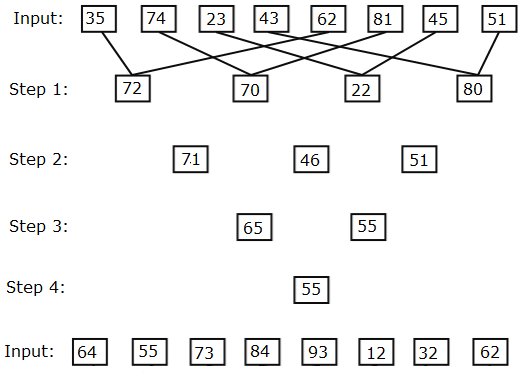
Which of the following is the second element from the right end in step 1 of the given input?
Direction: In the following letter series, how many times do PQR occur in such a way that Q is in the middle of P and R?
Q M P N P Q R R O P Q N O P P Q R P M Q R O P Q R P P R R P Q R P
Study the following information carefully and answer the questions given below:
Seven bankers namely - P, Q, R, S, T, U, and V hold different designations in the same bank viz.- Executive Director (ED), General Manager (GM), Deputy General Manager (DGM), Manager (MG), Assistant Manager (AM), Probationary Officer (P0), and Clerk. They all like to travel to different tourist places viz.- Daman, Manali, Shimla, Goa, Leh, Kullu, and Coorg. All the information is not necessary in the same order.
Note: - Designations are given in descending order from Executive director to Clerk. A banker can be terminated only by his/her higher designated officer but not an immediate higher officer.
The one who likes Coorg is as Deputy General Manager and terminates U, who doesn't like Goa. The designation of U is immediately higher than the one who likes Manali. The one who likes Goa is designated lower to T and the one who likes Leh but as much as higher than P, who likes Shimla. The one who likes Leh is not an Executive director. The one who likes Goa is terminated by T, who is neither General Manager nor likes Daman. Two persons are designated between R and the one who likes Daman. R terminates V, who doesn't like Manali. S is not designated higher to V.
How many persons are designated between V and the one who likes Leh?
Study the following information carefully and answer the questions given below:
Seven bankers namely - P, Q, R, S, T, U, and V hold different designations in the same bank viz.- Executive Director (ED), General Manager (GM), Deputy General Manager (DGM), Manager (MG), Assistant Manager (AM), Probationary Officer (P0), and Clerk. They all like to travel to different tourist places viz.- Daman, Manali, Shimla, Goa, Leh, Kullu, and Coorg. All the information is not necessary in the same order.
Note: - Designations are given in descending order from Executive director to Clerk. A banker can be terminated only by his/her higher designated officer but not an immediate higher officer.
The one who likes Coorg is as Deputy General Manager and terminates U, who doesn't like Goa. The designation of U is immediately higher than the one who likes Manali. The one who likes Goa is designated lower to T and the one who likes Leh but as much as higher than P, who likes Shimla. The one who likes Leh is not an Executive director. The one who likes Goa is terminated by T, who is neither General Manager nor likes Daman. Two persons are designated between R and the one who likes Daman. R terminates V, who doesn't like Manali. S is not designated higher to V.
Who among the following can terminate U?
I. The one who likes Leh
II. S
III. The one who likes Goa
Study the following information carefully and answer the questions given below:
Seven bankers namely - P, Q, R, S, T, U, and V hold different designations in the same bank viz.- Executive Director (ED), General Manager (GM), Deputy General Manager (DGM), Manager (MG), Assistant Manager (AM), Probationary Officer (P0), and Clerk. They all like to travel to different tourist places viz.- Daman, Manali, Shimla, Goa, Leh, Kullu, and Coorg. All the information is not necessary in the same order.
Note: - Designations are given in descending order from Executive director to Clerk. A banker can be terminated only by his/her higher designated officer but not an immediate higher officer.
The one who likes Coorg is as Deputy General Manager and terminates U, who doesn't like Goa. The designation of U is immediately higher than the one who likes Manali. The one who likes Goa is designated lower to T and the one who likes Leh but as much as higher than P, who likes Shimla. The one who likes Leh is not an Executive director. The one who likes Goa is terminated by T, who is neither General Manager nor likes Daman. Two persons are designated between R and the one who likes Daman. R terminates V, who doesn't like Manali. S is not designated higher to V.
Which of the following person likes Coorg?
Study the following information carefully and answer the questions given below:
Seven bankers namely - P, Q, R, S, T, U, and V hold different designations in the same bank viz.- Executive Director (ED), General Manager (GM), Deputy General Manager (DGM), Manager (MG), Assistant Manager (AM), Probationary Officer (P0), and Clerk. They all like to travel to different tourist places viz.- Daman, Manali, Shimla, Goa, Leh, Kullu, and Coorg. All the information is not necessary in the same order.
Note: - Designations are given in descending order from Executive director to Clerk. A banker can be terminated only by his/her higher designated officer but not an immediate higher officer.
The one who likes Coorg is as Deputy General Manager and terminates U, who doesn't like Goa. The designation of U is immediately higher than the one who likes Manali. The one who likes Goa is designated lower to T and the one who likes Leh but as much as higher than P, who likes Shimla. The one who likes Leh is not an Executive director. The one who likes Goa is terminated by T, who is neither General Manager nor likes Daman. Two persons are designated between R and the one who likes Daman. R terminates V, who doesn't like Manali. S is not designated higher to V.
Which of the following statement is/are true?
I. S terminates P and likes Manali
II. Two persons are designated between T and the one who likes Goa
III. V is terminated by the one who likes Coorg
Direction: Read the following information carefully and answer the questions that follow:
The information is provided in coded form. Decode the information to answer the questions that follow.
A # B means A is 3 km East of B.
A % B means A is 3 km West of B.
A @ B means A is 4 km North of B.
A < B means A is 4 km South of B.
If it is given that L @ P # Q @ R; S # R; S % O; N < M; N @ O, then what is the distance between N and P?
Direction: Read the following information carefully and answer the questions that follow:
The information is provided in coded form. Decode the information to answer the questions that follow.
A # B means A is 3 km East of B.
A % B means A is 3 km West of B.
A @ B means A is 4 km North of B.
A < B means A is 4 km South of B.
If it is given that Z < R; V % X @ Y; V < W; U @ W; U # R, then what is the shortest distance between V and Y?
Direction: Read the following information carefully and answer the questions that follow:
The information is provided in coded form. Decode the information to answer the questions that follow.
A # B means A is 3 km East of B.
A % B means A is 3 km West of B.
A @ B means A is 4 km North of B.
A < B means A is 4 km South of B.
If it is given that L @ P # Q @ R; S # R; S % O; N < M; N @ O, then which of the following statement(s) is/are true?
i) L is to the Northeast of N.
ii) Distance between P and O is 5 km.
iii) M is to the Southwest of R.
Direction: Read the following information carefully and answer the questions that follow:
The information is provided in coded form. Decode the information to answer the questions that follow.
A # B means A is 3 km East of B.
A % B means A is 3 km West of B.
A @ B means A is 4 km North of B.
A < B means A is 4 km South of B.
If it is given that Z < R; V % X @ Y; V < W; U @ W; U # R, then what is the direction of X with respect to Z?
Direction: Read the following information carefully and answer the questions that follow:
The information is provided in coded form. Decode the information to answer the questions that follow.
A # B means A is 3 km East of B.
A % B means A is 3 km West of B.
A @ B means A is 4 km North of B.
A < B means A is 4 km South of B.
If it is given that L @ P # Q @ R; S # R; S % O; N < M; N @ O, then what is the direction of N with respect to Q.
Study the following information carefully and answer the questions given below
Eight persons-J, K, L, M, N, O, P, and Q are like different cookies- Cadbury, Horlicks, Kwality, Britannia, Parle-G, Sunfeast, Unibic, and Anmol and they are like different flavor ice creams- Vanilla, Butter Pecan, Pistachio, Coffee, Mint, Chocolate, Strawberry, and Caramel. All the information is not necessarily in the same order.
M likes Unibic cookies and likes Strawberry ice cream. Either L or O likes Coffee flavor. Neither P nor Q likes Cadbury cookies and Mint flavor. The one who likes Parle-G is also like Mint flavor ice cream. O and K like Britannia cookies and Chocolate ice cream respectively. The one who likes Cadbury is like neither Chocolate nor Coffee ice cream. J does not like Parle-G. Neither N nor L likes Cadbury. The one who likes Pistachio flavor is neither like Kwality nor Cadbury. Either L or Q likes Butter Pecan. The one who likes Britannia is either likes Coffee or Vanilla flavor. The one who likes Caramel does not like Cadbury. Neither L nor Q likes Anmol. Either P or K likes Horlicks. Neither the one who likes chocolate nor the one who likes Caramel is like Horlicks cookies. Neither the one who likes Butter pecan nor the one who likes Caramel is like Sunfeast. The one who likes Butter pecan does not like Anmol. Q doesn’t like Pistachio.
Which of the following flavor P likes?
Study the following information carefully and answer the questions given below
Eight persons-J, K, L, M, N, O, P, and Q are like different cookies- Cadbury, Horlicks, Kwality, Britannia, Parle-G, Sunfeast, Unibic, and Anmol and they are like different flavor ice creams- Vanilla, Butter Pecan, Pistachio, Coffee, Mint, Chocolate, Strawberry, and Caramel. All the information is not necessarily in the same order.
M likes Unibic cookies and likes Strawberry ice cream. Either L or O likes Coffee flavor. Neither P nor Q likes Cadbury cookies and Mint flavor. The one who likes Parle-G is also like Mint flavor ice cream. O and K like Britannia cookies and Chocolate ice cream respectively. The one who likes Cadbury is like neither Chocolate nor Coffee ice cream. J does not like Parle-G. Neither N nor L likes Cadbury. The one who likes Pistachio flavor is neither like Kwality nor Cadbury. Either L or Q likes Butter Pecan. The one who likes Britannia is either likes Coffee or Vanilla flavor. The one who likes Caramel does not like Cadbury. Neither L nor Q likes Anmol. Either P or K likes Horlicks. Neither the one who likes chocolate nor the one who likes Caramel is like Horlicks cookies. Neither the one who likes Butter pecan nor the one who likes Caramel is like Sunfeast. The one who likes Butter pecan does not like Anmol. Q doesn’t like Pistachio.
Which of the following statement is true?
I. N likes Caramel
II. M likes Mint
III. The one who likes Anmol likes Caramel flavor
IV. Q likes Chocolates



